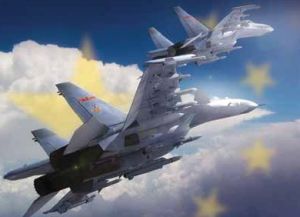This article is published with the kind permission of “Defence and Security Alert (DSA) Magazine” New Delhi-India
A perceptive article on the growth and evolution of the PLAAF. In the early years, PLAAF was conceptualised as ancillary and long range artillery of the army; PLAAF was quick to embrace RMA after the Gulf war and by the turn of the century started consolidating on various aspects like informatised and asymmetric warfare techniques and enhance its strategic power projection capability in an effort to build itself into a strategic air force by 2020. China’s use of airpower in the 21st century is also guided by the philosophy of coercion aimed at compelling to change the behaviour of the target State. The total number of fighter and bomber aircraft with PLAAF in 2000 consisted of 1900 J‑6; 720 J‑7; 222 J‑8; 55 Su 27/J‑11; 440 Q‑5 (modified MiG 19); 305 H‑5/IL-28; 142 H‑6/Tu-16 and just about a dozen JH‑71 . Its front line bomber fleet consists of no more than a hundred H‑6 aircraft with a weapon carrying payload capacity limited to 20,000 pounds; the period did see a change in PLAAF’s profile from an earlier force which consisted of basic fighters with limited radius of action, low end avionics and limited fire power capabilities to a force equipped with AWACS, air to air refuelling and multi-role tactical aircraft with high end avionics, firepower and extended radius of action to reach at least the first island chain, Spratly and Paracel.
 |
It’s been a haughty journey for the Chinese air force since its creation from a small army unit based in Wuhan in the middle of the twentieth century. In the early years, PLAAF was conceptualised as ancillary and long range artillery of the army; which continued to be the guiding philosophy for more than three decades until the command was handed over to a hard-core air force professional — Wang Hai. China during the course of PLAAF’s evolution has had a number of visionaries who believed that air power should be central to the military strategy and therefore underlined the importance of it being effectively employed in the calculus of war-fighting doctrine. In fact Mao as early as in 1949 had mentioned that other than having a powerful army; it was also imperative for China to build a powerful air force and a navy. Hence it was not only the military but also the political leadership which had a vision for the air force, though, in its periphery, but at the same time acknowledging the importance of employability and the efficacy of air power in future battle space.
Ideation
However, China’s security dilemma and PLAAF’s evolution basically stems from its political leadership guided by Mao, Zhou, Deng and Jiang. Mao’s military philosophy was deep-rooted in ‘People’s War’; and also reflected in the large numbers of antiquated and laggard aircraft in the air force during that period. Both Mao and Zhou were offensive realists; though Zhou much lesser of the two; and China’s security strategy largely expounded an intolerant approach; observed the world as a hostile place and considered that its entire security dilemma was a result of the other countries imperialistic policies. However Deng and Jiang more sober; integrationist and believed in the principle of engagement and cooperation; which was also the hallmark of defensive realism and a pillar of China’s security stratagem in the Deng-era. Hence, post-Mao, there was an apparent transformation of the State’s policy from ‘offensive to defensive realism’ and China as a result was pushing hard to pursue a strategy of maintaining amicable relationship with its neighbours. The transmutation of the evolutionary shift in the post-Mao era was followed by propagation of Four Modernisations; favouring modernisation of all sectors in the economy. The concept had been propagated by Zhou in January of 1975 while speaking before the fourth National People’s Congress and Deng carried it forward by laying emphasis on modernisation of agriculture followed by industry, science and technology and then national defence. The Four Modernisations did not however catalogue military or national defence as its last pillar; but only stated an idea that national defence must be built on a country’s economic strength and therefore, it was first essential to strengthen the fundamentals before initiating the process of its military modernisation.
————————–
1 Frank W Moore, “China’s Military Capabilities”, Published for Institute for Defence and Disarmament Studies, Cambridge MA, June 2000.

 von
von 

